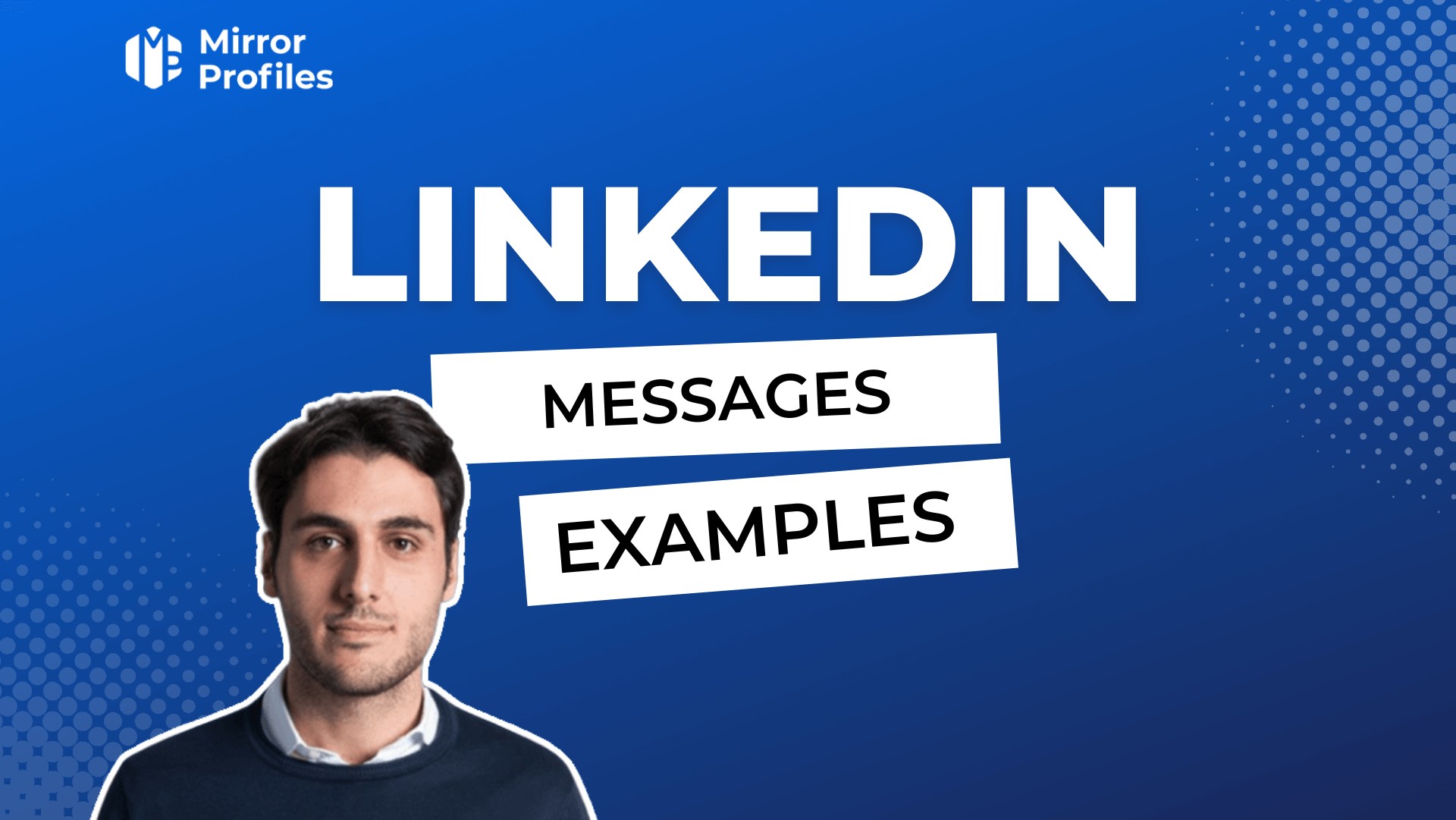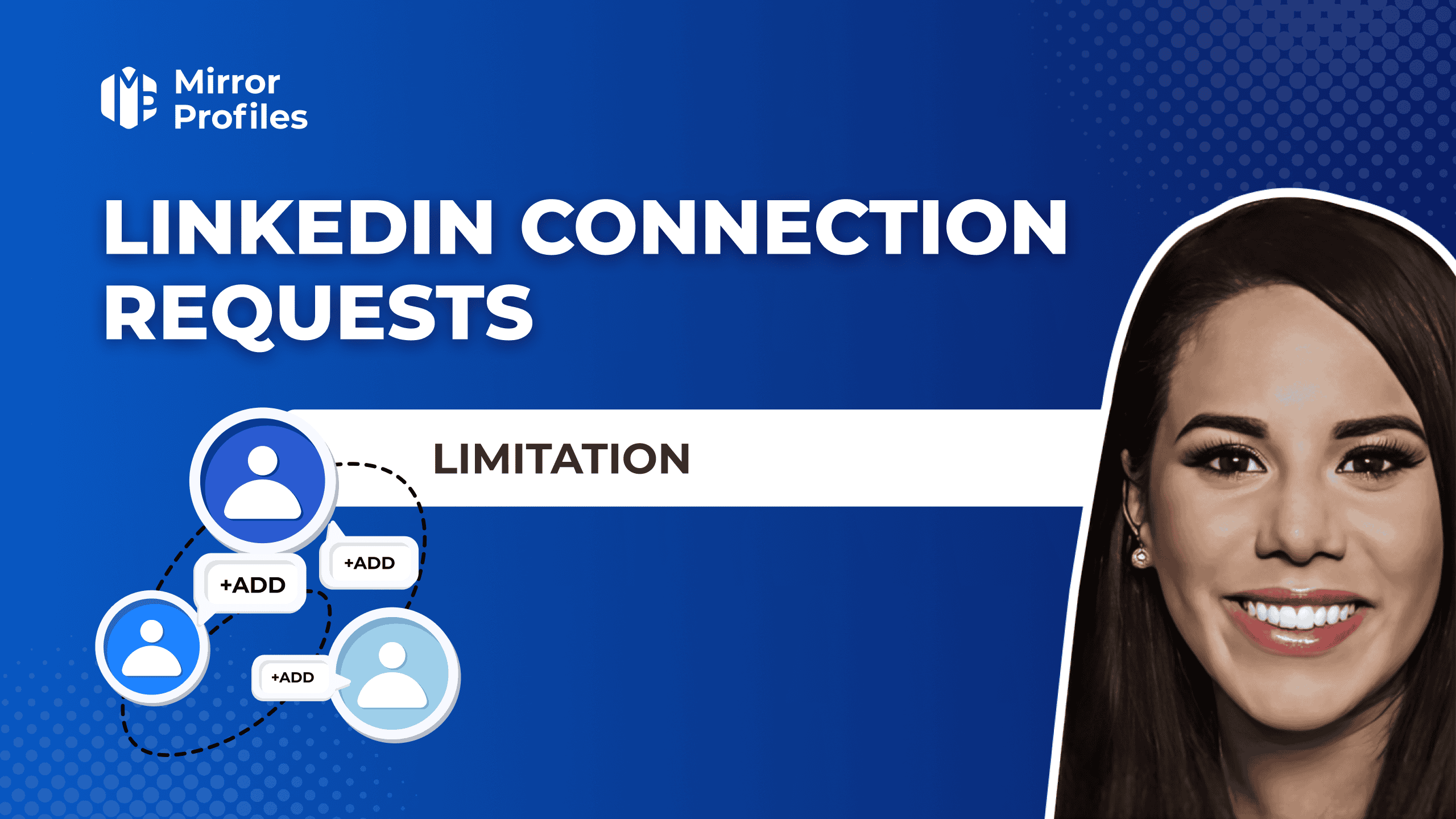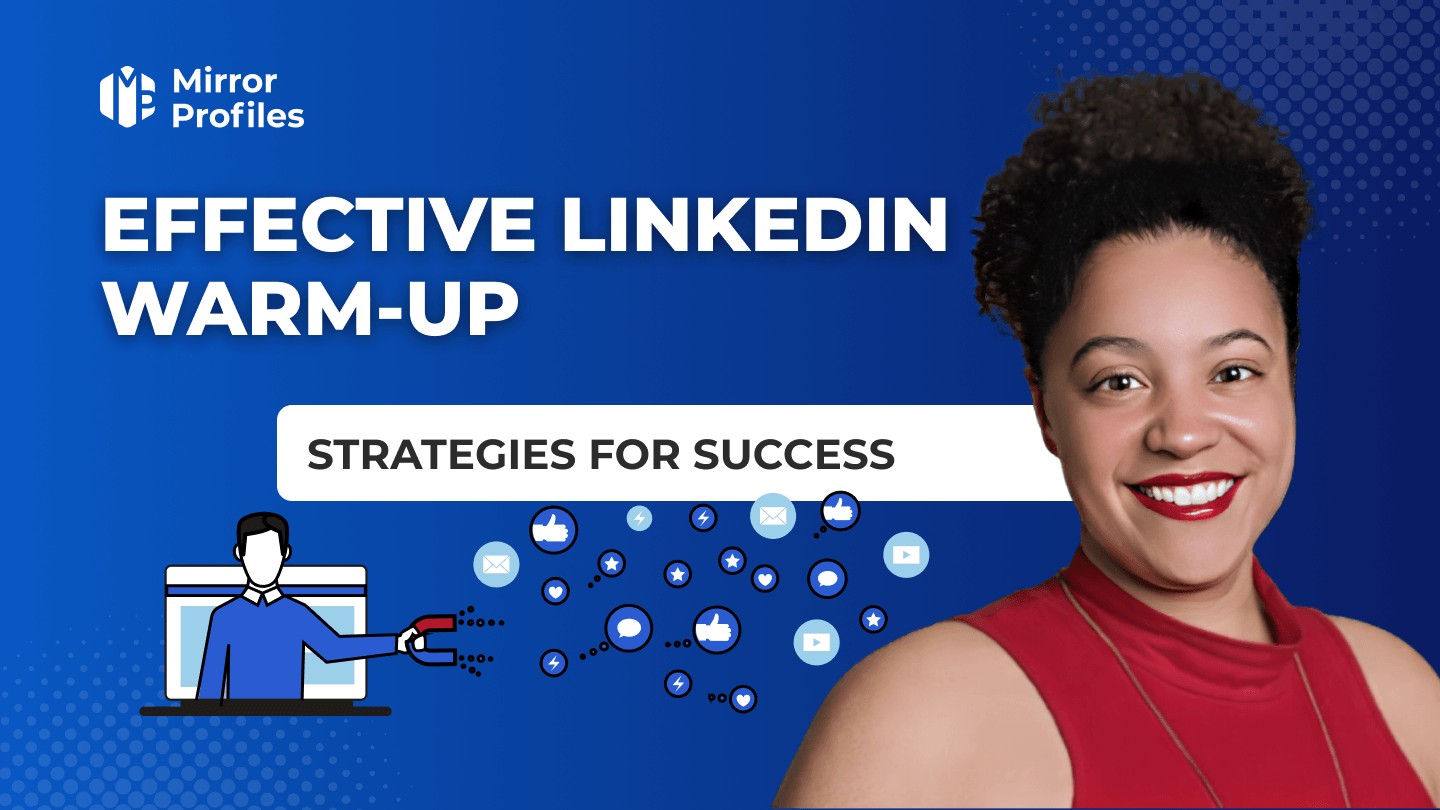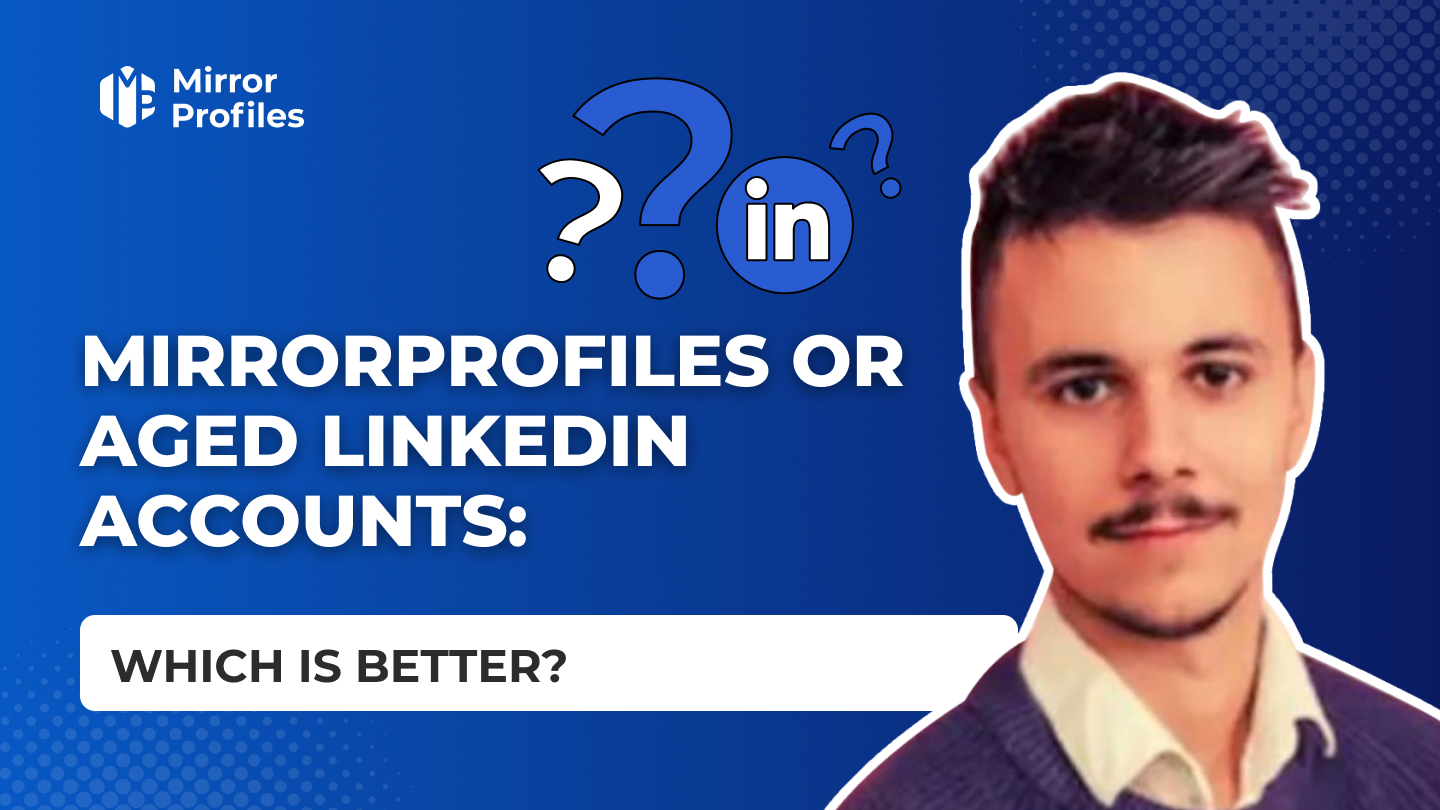Introduction
Copywriting is a difficult exercise. Convincing someone by message on LinkedIn isn’t easy, and it takes time. It’s an art and a science in its own right, requiring not only an impeccable command of language, but also a deep understanding of human psychology and consumer behavior. To increase the effectiveness of your prospecting messages, it’s crucial to understand how to use networking tools like LinkedIn, sending personalized invitations via messaging and using tools like CRM to track your interactions with your prospects.
Copywriting is a difficult exercise. Convincing someone by message on LinkedIn isn’t easy, and it takes time.
It’s an art and a science in its own right, requiring not only an impeccable command of language to write engaging content, but also a deep understanding of human psychology and consumer behavior.
MirrorProfiles lets you rent several Linkedin accounts to optimize your prospecting in terms of quantity.
But without good copywriting, quantity is of little use.
In this guide, we’ll explore what copywriting is, how it can be used to generate appointments, interviews, and even help fill out questionnaires via LinkedIn.
Whether you’re a professional communications member, a business owner or simply interested in the power of words, this guide is for you.
In addition, we’ll discuss some strategies and best practices for increasing acceptance of your LinkedIn connection requests and improving the effectiveness of your messages, based on real-life examples of successful conversations.
What is copywriting?
Copywriting, also known as “advertising copywriting” or “sales copywriting”, is a written communication technique that seeks to influence the reader to take a certain action on a professional platform such as LinkedIn.
This action may be to buy a product, subscribe to a service, sign up for a newsletter, join a group or any other objective set by the company or organization.
The aim of copywriting is to elicit an emotion or reaction that prompts the reader to take action.
To achieve this goal, copywriting uses a variety of persuasive strategies, including leveraging LinkedIn’s features to connect with prospects:
- Highlighting the benefits of the product or service
- Identifying the needs and desires of the target audience
- The argument that resonates most with your target audience. The famous SONCAS technique.
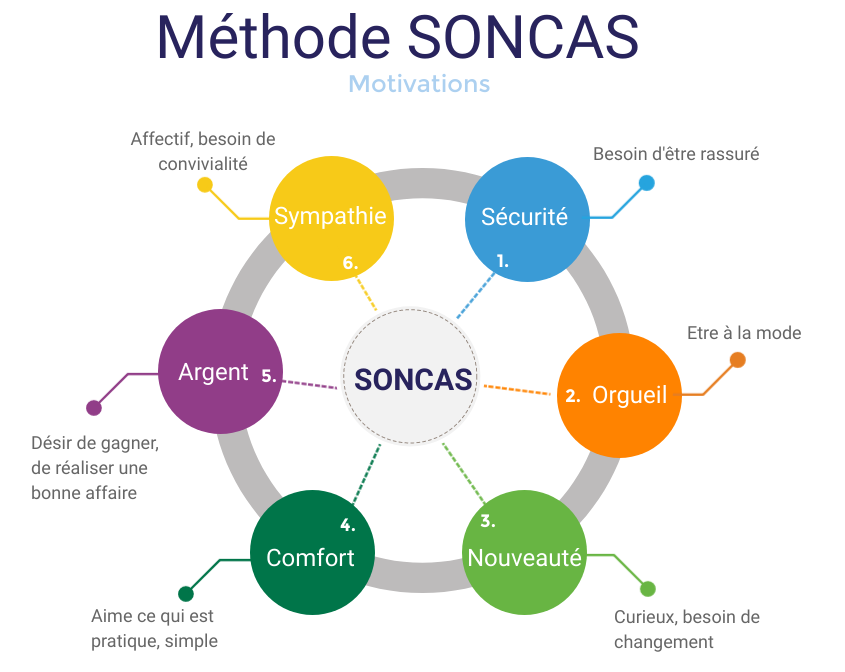
Copywriting requires a good understanding of consumer psychology and an excellent command of the language in which the message is written. A good copywriter is able to write texts that attract attention, arouse interest, provoke desire and incite action, thus following the famous AIDA formula (Attention, Interest, Desire, Action), using tools like LinkedIn messaging to engage effective discussion.
Tailor your message to the audience: It’s crucial to understand that every audience on LinkedIn is unique.
This means adapting the tone, style and content of your messages according to the person you’re addressing, which is often overlooked but can significantly increase the effectiveness of your prospecting messages.
Another important aspect of copywriting is the call to action (CTA).
A CTA is a clear, precise instruction that tells the reader what to do next, such as click on a link, accept an invitation or start a conversation on LinkedIn.
For example, “Buy now”, “Sign up today” or “Contact us via LinkedIn messaging for more information” are all examples of calls to action.
It’s also essential to check and update the spelling and grammar of your messages on LinkedIn.
A spelling mistake or typo can tarnish your professional image and diminish the impact of your message, affecting your relationships and connections.
It’s also important to end each message on a positive note, thanking the recipient for their time and looking forward to meeting or collaborating with them soon on LinkedIn.
Expressing gratitude and positive anticipation can create a lasting, friendly impression, strengthening your professional network.
In short, copywriting is both an art and a science. It requires both writing skills and a deep understanding of human behavior. Effective copywriting is that which manages to connect with the audience on LinkedIn, understand their needs and persuade them to act, using proven message templates.
Copywriting to generate appointments
The main aim of this approach is to generate enough interest for a prospect to agree to a meeting on LinkedIn. To do this, you need to be clear and precise, while carefully targeting your prospect. Here are some tips to improve your response rates and maximize your chances of connecting with potential prospects on LinkedIn:
- Use a strong, concrete hook: The aim is to grab your prospect’s attention right from the start. You need to create a hook that highlights the problem your product or service can solve for the prospect.
- Ask an open-ended question about the customer’s problem: By asking a question, you invite your prospect to think about his or her problems and consider how your solution might help.
- Personalize your message: It’s important to show prospects that you’ve researched them and understand their situation. For example, paraphrasing your job or professional situation can create a more personal connection and increase the chances of a positive response.
- Briefly present your solution: Explain how your product or service could be of interest to the prospect. Don’t forget to emphasize the novelty of your solution and how it can meet the specific needs of the sector in which it operates.
- Use social proof: testimonials from satisfied customers or case studies can reinforce the credibility of your offer and convince readers to take action.
- Use a strong, concrete hook: The aim is to grab your prospect’s attention right from the start. You need to create a hook that highlights the problem your product or service can solve for the prospect on LinkedIn.
- Use a strong, concrete hook: The aim is to grab your prospect’s attention right from the start. You need to create a hook that highlights the problem your product or service can solve for the prospect.
- Ask an open-ended question about the customer’s problem: By asking a question, you invite your prospect to think about his or her problems and consider how your solution might help.
- Ask an open-ended question about the customer’s problem: By asking a question, you’re inviting your prospect to think about their problems and consider how your solution could help them in their professional field.
- Personalize your message: It’s important to show prospects that you’ve researched them and understand their situation. For example, paraphrasing your job or professional situation can create a more personal connection and increase the chances of a positive response.
- Briefly present your solution: Explain how your product or service could be of interest to the prospect. Don’t forget to emphasize the novelty of your solution and how it can meet the specific needs of the sector in which it operates.
- Personalize your message: It’s important to show prospects that you’ve researched them and understand their situation. For example, paraphrasing your job or professional situation can create a more personal connection and increase the chances of a positive response.
- Use social proof: testimonials from satisfied customers or case studies can reinforce the credibility of your offer and convince readers to take action.
Let’s take the following example.
Here, we’re prospecting for our real estate customer, who is a marketplace for new properties:
“Hello {{firstname}},
First of all, thank you for accepting my invitation. I’m currently carrying out an in-depth study on the detection and analysis of new properties in your area. The aim is to interview real estate or heritage experts working in an agency.
How do you go about quickly sourcing and scoring the right new properties for your customers?”
This message is an effective example of copywriting to generate appointments for several reasons: it clarifies the purpose of the approach (a study on the detection and analysis of new properties), which lends legitimacy to the request; it asks an open-ended question about the prospect’s problem (“How do you go about sourcing and scouting new properties suitable for your customers today?”).
This encourages the prospect to respond and engage in conversation via LinkedIn messaging; it specifically targets “real estate or heritage experts working in an agency”, showing that the message is personalized and that the sender has a good understanding of the audience he’s targeting.
- He clarifies the purpose of the approach (a study on the detection and analysis of new properties), which lends legitimacy to the request.
- It poses an open-ended question about the prospect’s problem (“How do you go about quickly sourcing and scoring new properties suitable for your customers?”).
This encourages the prospect to respond and engage in the conversation. - It specifically targets “real estate or heritage experts working in an agency”, which shows that the message is personalized and that the sender has a good understanding of his target audience.
- He clarifies the purpose of the approach (a study on the detection and analysis of new properties), which lends legitimacy to the request.
- He clarifies the purpose of the approach (a study on the detection and analysis of new properties), which lends legitimacy to the request.
- It poses an open-ended question about the prospect’s problem (“How do you go about quickly sourcing and scoring new properties suitable for your customers?”).
This encourages the prospect to respond and engage in the conversation. - It asks an open-ended question about the prospect’s problem (“How do you go about quickly sourcing and scoring new properties suitable for your customers today?”).
This encourages the prospect to respond and engage in conversation via LinkedIn messaging. - It specifically targets “real estate or heritage experts working in an agency”, which shows that the message is personalized and that the sender has a good understanding of his target audience.
Send reminders: Studies show that response rates increase significantly with reminders.
It’s therefore advisable to send a minimum of 3 to 4 follow-ups to maximize your chances of generating an appointment.
Use tools like LinkedIn Navigator to track your interactions and optimize your prospecting campaigns on your professional network.
For the following messages, it’s then easy to talk about what our customer is doing by offering their services to source new properties via targeted discussions on LinkedIn.
By taking care to update and optimize your LinkedIn profile, you’ll increase the credibility of your approach.
Before sending out prospecting messages, make sure your LinkedIn page is complete, professional and engaging to maximize the impact of your messages.
By following these tips, your copywriting will be more effective in generating appointments and building strong professional relationships on LinkedIn.
Copywriting to generate leads
In the context of recruitment, copywriting plays a key role in attracting potential candidates via LinkedIn. This approach requires a softer tone, a human, clear and concise message. Here’s how you can connect with potential prospects on LinkedIn:
- Be genuine and sympathetic: Point out something interesting in their background to show that you’ve done your research.
- Offer a clear opportunity: Explain the position you’re offering in simple, friendly terms.
- Reassure the prospect: Show that you’re looking for people with certain skills and that your company offers certain advantages. This will alleviate any concerns the prospect may have about his or her suitability for the job.
- Invite action: Encourage the candidate to talk with you.
This could mean asking them to talk about their plans, or offering to talk to you about the position. - Conclude positively: End your message on a positive note by wishing the prospect a good day and expressing the hope of seeing them again soon.
- Be genuine and sympathetic: Point out something interesting in his or her background to show that you’ve done your research and want to establish a professional relationship.
- Be genuine and sympathetic: Point out something interesting in their background to show that you’ve done your research.
- Offer a clear opportunity: Explain the position you’re offering in simple, friendly terms.
- Offer a clear opportunity: Explain the job you’re offering in simple, friendly terms, highlighting the professional benefits.
- Reassure the prospect: Show that you’re looking for people with certain skills and that your company offers certain advantages. This will alleviate any concerns the prospect may have about his or her suitability for the job.
- Invite action: Encourage the candidate to talk with you.
This could mean asking them to talk about their plans, or offering to talk to you about the position. - Conclude positively: End your message on a positive note by wishing the prospect a good day and expressing the hope of seeing them again soon for a job opportunity.
- Conclude positively: End your message on a positive note by wishing the prospect a good day and expressing the hope of seeing them again soon.
Take this message, for example:
“Hello {{firstName}},
Thank you for accepting me into your network. You have a very interesting career path and I’d like to talk to you about joining us on an open-ended contract in a retirement expertise position.
This is a new position, so it may come as a surprise that I’m contacting you for this one, but we’re looking for people who are rigorous, organized and have already worked in professions where compliance with procedures is important 🙂 If you’re interested in the job, we have a whole internal training program, so no worries on that score.
Can we discuss this in person so that you can tell me about your plans and I can tell you about the job?
I wish you a lovely day and hope to see you soon!”
This message is effective because it’s clear, engaging and friendly. It’s long, too long if you don’t have many potential candidates. But for a job where there are potentially many good profiles, you shouldn’t hesitate, especially if you automate requests via LinkedIn. In fact, copywriting should be used like a funnel or scoring method to maximize results.
The message emphasizes the prospect’s value, details the opportunity offered and reassures the prospect by talking about in-house training.
In addition, it uses a positive tone and gives the prospect the opportunity to learn more in an interview, creating a strong incentive to action and reinforcing the professional relationship.
Optimize your LinkedIn profile: Before sending out prospecting messages or interview requests, make sure your LinkedIn profile is optimized.
This includes a professional profile photo, a clear headline, a detailed description of your skills and experience, and links to your relevant activities and content.
Copywriting for filling out questionnaires
Gathering feedback is essential for any company looking to improve its services or products. Copywriting can help to obtain this valuable data by motivating people to fill in questionnaires via LinkedIn.
Here’s how you can go about sending effective messages:
- Humanize your message: Your message should show empathy and appreciation for the prospect’s expertise.
This will make the recipient feel valued. - Be concise and clear: Keep your message short and to the point. People are more likely to respond to a message that gets straight to the point and respects their time.
- Present your request: Explain what you want from the person. In this case, you’d like her to fill in a short questionnaire.
- Highlight the importance of their contribution: Explain how their help could benefit your project. This might motivate them to participate.
- Humanize your message: Your message should show empathy and appreciation for the prospect’s expertise.
This will make the recipient feel valued and strengthen your network of professional contacts. - Humanize your message: Your message should show empathy and appreciation for the prospect’s expertise.
This will make the recipient feel valued.
- Be concise and clear: Keep your message short and to the point. People are more likely to respond to a message that gets straight to the point and respects their time.
- Present your request: Explain what you want from the person. In this case, you’d like her to fill in a short questionnaire via LinkedIn Messenger.
- Present your request: Explain what you want from the person. In this case, you’d like her to fill in a short questionnaire.
- Highlight the importance of their contribution: Explain how their help could benefit your project. This might motivate them to participate.
- Highlight the importance of their contribution: Explain how their help could benefit your project. This may motivate them to participate and engage in constructive conversation.
Let’s see how these principles apply to the following example:
“Hello {{firstName}},
I’ve seen that you have solid delivery experience.
I’m working on a new innovation project to simplify delivery, and it would be really great to hear from you.
Would you be willing to give me your opinion on this? I have a very short questionnaire to send you.
That would help me a lot.”
This message is effective because it respects all the guidelines mentioned above. It targets a person with specific expertise, presents a clear and concise request, and emphasizes the importance of their contribution to the project.
As a result, the recipient is more likely to feel valued and therefore willing to help, strengthening your relationships on LinkedIn.
We’ve seen in these four parts just how much copywriting is a constantly evolving art, requiring not only a good understanding of your target audience, but also a mastery of persuasive techniques to incite action.
Copywriting needs to be adapted to the field and sector in which you operate, using tools like LinkedIn to connect with prospects and send personalized messages.
Appointment-generating copywriting involves writing clear, precise and personalized messages that capture your prospect’s attention from the very first line. The message must highlight a problem that your product or service can solve for the prospect, and present a new, innovative solution. Use effective message templates and test them regularly to improve your results on LinkedIn.
Interview copywriting requires a gentler, more human approach. It’s essential to show the person that you’ve researched their background, to offer a clear opportunity and to reassure the prospect of their suitability for the proposed position. Recruitment messages should be less aggressive and include a clear call to action via LinkedIn messaging.
Copywriting for filling in questionnaires is based on humanizing the message and presenting a clear, concise request.
It’s important to emphasize the prospect’s expertise and the importance of their contribution to your project.
Use marketing tools like LinkedIn to track interactions and optimize your campaigns.
However, copywriting is not an exact science. Every audience is unique, and what works for one audience may not work for another. Copywriting must therefore be constantly tested, evaluated and optimized. This is not a one-off effort, but a continuous process of improvement and adjustment. The key to success in copywriting is a deep understanding of your audience and the ability to tailor your message to meet their specific needs and desires on LinkedIn.
Bonus: Would you like some help with your copywriting?
Stepward is the best agency to manage your MirrorProfiles accounts and offers leadgen support to boost your prospecting. Stepward is also working with one of its customers, Qualiretraite, in this direction. Thanks to their 4 MirrorProfiles accounts, this company is deploying a massive recruitment campaign to generate interviews efficiently with Stepward’s expertise. Every three weeks, the Stepward team and Qualiretraite rework the campaigns together, including copywriting and ab testing, to optimize recruitment campaigns and improve results.


